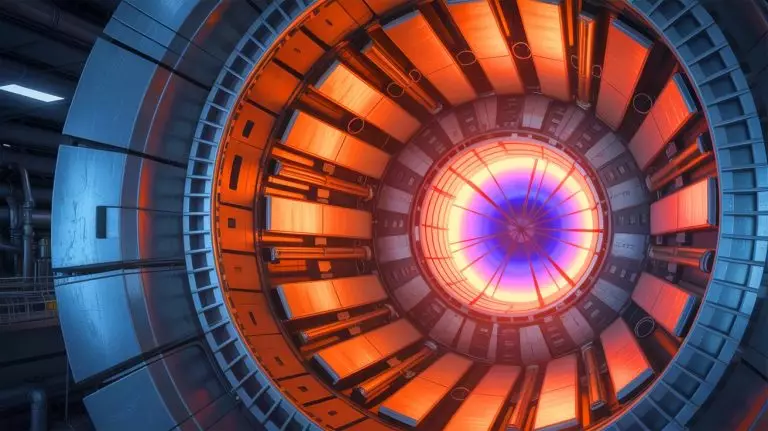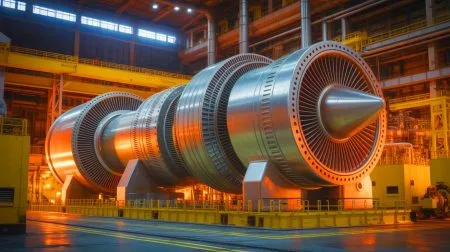| IN A NUTSHELL |
|
Swiss researchers at the École Polytechnique Fédérale de Lausanne (EPFL) have made an exciting breakthrough that could revolutionize the future of energy production. They have discovered a novel way to prevent tokamak fusion reactors from overheating, thereby making them more efficient and reliable. This advancement, known as the X-point target radiator (XPTR), not only controls excess heat but also promises to improve reactor performance over time. With the potential to solve one of fusion’s most significant challenges, this discovery might be a pivotal step towards achieving sustainable and clean energy through nuclear fusion.
Understanding the Tokamak Reactor
Tokamak reactors represent one of the most promising avenues for achieving nuclear fusion on Earth, a process that mimics the energy production of the Sun. These reactors utilize powerful magnetic fields, arranged in a doughnut shape, to contain and heat a gas known as plasma. As this plasma becomes exceedingly hot, it behaves like an electrically charged fluid, setting the stage for nuclear fusion to occur. The fusion process generates immense heat, some of which escapes and impacts the reactor’s internal surfaces, particularly in an area called the divertor.
The divertor is crucial because it channels away excess plasma and heat, preventing damage to the reactor. However, the continuous heat exposure poses a significant challenge, as it can degrade the reactor’s components over time. The EPFL team’s innovative approach to reducing the heat load on a tokamak’s inner walls could address this issue effectively. By introducing a secondary X-point further down the divertor channel, their design aims to dissipate heat more evenly and enhance the reactor’s operational stability and longevity.
Fusion: The Energy Holy Grail
Nuclear fusion is often heralded as the holy grail of energy due to its potential to provide a virtually limitless, clean source of electricity. Unlike traditional nuclear power, which relies on fission and generates radioactive waste, fusion merges light atoms like hydrogen to form a heavier one, such as helium, releasing massive energy without harmful emissions. Scientists have long sought to harness this reaction on Earth, with tokamak reactors being a leading contender in this quest.
However, achieving controlled fusion is fraught with challenges, primarily due to the intense heat generated during the process. This heat, if not managed properly, can damage reactor components, making sustained fusion reactions difficult to maintain. The EPFL team’s discovery of the XPTR could be a game-changer, offering a viable solution to controlling and utilizing this heat effectively. By reducing the heat load on critical reactor areas, the XPTR makes the dream of practical fusion energy more attainable.
Cooler, More Efficient Tokamaks
The introduction of a secondary X-point in the tokamak design is a significant advancement in fusion technology. This additional X-point allows heat to be radiated away more uniformly, reducing damage to the reactor’s vulnerable parts while maintaining plasma stability. Importantly, this design does not interfere with the central plasma, which is essential for sustained fusion reactions. The innovation also proves versatile, functioning across a wide range of conditions and adding to its reliability and scalability.
MIT and Commonwealth Fusion Systems plan to incorporate this design into SPARC, their upcoming major fusion project. Ongoing experiments and simulations aim to refine this technology further, preparing it for application in future power plants. The XPTR’s ability to manage heat safely without compromising the reactor’s integrity addresses one of the most significant obstacles to fusion energy, inching closer to making fusion a practical energy solution.
The Path Forward: Challenges and Opportunities
While the discovery of the XPTR marks a significant milestone in fusion research, several challenges remain. Engineering a reactor that can sustain fusion reactions over extended periods requires meticulous design and innovation. The scalability of the XPTR and its integration into existing and future reactor designs will be critical in determining its success. Additionally, ongoing research and development will be necessary to adapt this technology to various reactor configurations and operational conditions.
Nonetheless, the potential benefits of mastering fusion energy are immense. By providing a clean, sustainable, and virtually limitless energy source, fusion could play a crucial role in combating climate change and reducing reliance on fossil fuels. As researchers continue to refine these technologies, the question remains: how soon can we expect to see fusion energy become a staple of our power grid, transforming the way we generate and consume energy?
Did you like it? 4.3/5 (26)








Wow, this is a game-changer! How soon can we start using fusion energy in our daily lives? 🔥
Is it just me or does “X-point target radiator” sound like something out of a sci-fi movie? 🤖
What are the potential environmental impacts of this technology?
Can this technology be applied globally, or is it just for specific regions?
Is the XPTR patent-protected or open for development by other countries?
What a fascinating breakthrough! Kudos to the researchers involved. 👏
How long until we can see a functional fusion power plant using this technology?
Does this mean electricity bills could drop in the future?
I hope this doesn’t turn out to be another overhyped tech. Fingers crossed! 🤞
Are there any known limitations of the XPTR design?
Thanks for this insight! It’s incredible to see science pushing boundaries. 🚀
Great article! Thanks for sharing this groundbreaking information. 🙌
Could this technology help in space exploration missions too?
I’m excited, but how reliable is this new method in the long run?
It’s about time we had some positive news in energy tech! 🌍
Any updates on how other countries are reacting to this discovery?
Is there a risk of these reactors actually exploding without the XPTR?
I love the idea, but will it be affordable for developing countries?
This is a big step forward! How can we support further research?
I have a question: how is the secondary X-point managed in the reactor?
Sounds promising, but what are the next steps in developing this tech?
Fascinating topic, but I got a bit lost in the technical details. 🤯
Are there any partnerships in place to commercialize this technology?
What happens if the XPTR fails during a fusion reaction?
I wonder how expensive it will be to implement this technology on a large scale?
Thank you for the article! It’s good to see progress in clean energy. 🌞
How does this compare to other fusion reactor cooling methods?
How will this impact existing fusion projects like ITER?
Great to see innovation in action! Are there any videos explaining this? 📹
Look up Spinlaunch Tnunderf00t on YouTube ……it’s a scam ❗
This is amazing, but I’m a bit skeptical. Haven’t we heard promises about fusion before?
Can’t believe we’re finally making progress with fusion! 🌟
Is there any chance this technology could be dangerous?
How does this affect current nuclear power plants?
Awesome read! I was always curious about how fusion reactors work. 🔍